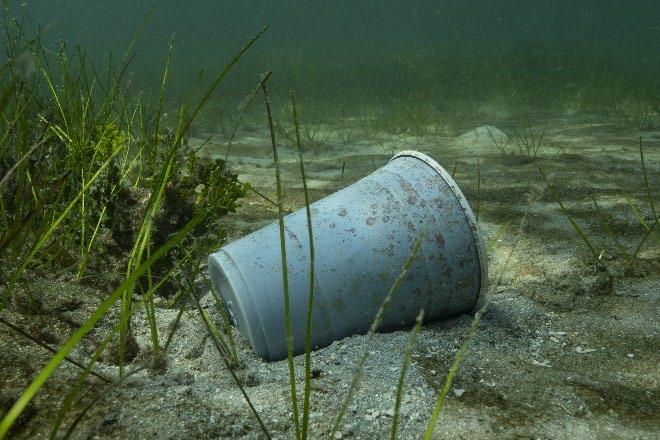
2 minute read
The Problem of Plastic in the Ocean
The oceans face a massive and growing threat from something we encounter every day: plastic. Peer-reviewed scientific studies have estimated that 15 million tons of plastic washes into the ocean every year. 3 This is roughly equivalent to dumping two garbage trucks full of plastic into the oceans every minute.
A recent review found that more than 900 species have ingested or become entangled in plastic, from zooplankton at the bottom of the ocean food web, to seabirds at the top. 4 Scientists found that more than half of all sea turtle species studied — 52% — have ingested plastic. 5 Sea turtles and other animals can mistake plastic bags for jellyfish or algae, their typical food. Research shows that sea turtles can even mistake the smell of plastic for food, often leading to a deadly outcome. 6 In a recent study, Oceana found evidence of nearly 1,800 animals from 40 different species swallowing or becoming entangled in plastic since 2009 in the U.S. 7 Of those, a staggering 88% were species listed as endangered or threatened with extinction under the U.S.’ Endangered Species Act.
A research paper from 2018 published in the journal Science assessed the influence of plastic waste on disease risk in 124,000 reef-building corals from 159 reefs in the Asia Pacific region. 8 The authors found that the likelihood of disease increases from 4% to 89% when corals are in contact with plastic, and they estimated that 11.1 billion plastic items are entangled on coral reefs across the Asia-Pacific region. Seventeen percent of the coral species observed to be affected by marine plastic debris are listed as threatened or near threatened with extinction by the International Union for the Conservation of Nature. 9 While corals face many threats including increased sea-surface temperatures, and ocean acidification, plastics clearly play a contributory role in reducing the health of coral ecosystems. The threatened health of coral reefs and diverse habitats globally has a direct impact on the tourism industry.
Once plastic reaches the ocean, it breaks up into smaller and smaller pieces, ultimately becoming microplastics that attract and harbor harmful chemical pollutants. 10 When eaten by fish and shellfish, some of the contaminants attached to microplastics work their way into our food supply. Everything from salt to honey to beer has been found to contain microplastics. 11 Scientists are still studying how humans might be affected by the plastics that are making their way into our food, water, and air. 12
Recycling is a false solution to the plastics crisis. According to a recent study, as of 2015 approximately 8.3 billion metric tons of plastic had been produced since the 1950s, and 6.3 billion metric tons has become waste. 13 Of this plastic waste, a mere 9% has been recycled. Twelve percent was incinerated and 79% accumulated in landfills, on the ground, or in the ocean.
To tackle the problem of marine plastic pollution, it is essential that we reduce the production and use of plastic and replace needless single-use plastic items with reusable alternatives. Where reusable items aren’t feasible, plastic should be replaced with other, easily recyclable materials that have a low environmental impact.










